Optimized High-Input Practice Enhances Wheat Productivity and Water Use Efficiency by Improving Root Distribution and Canopy Photosynthesis
Abstract
1. Introduction
2. Results
2.1. Shoot Number and Root Number
2.2. Root Distribution
2.3. Soil Water Consumption
2.4. Stage ET and Stage WUE
2.5. Canopy Apparent Photosynthetic Rate
2.6. Grain Yield and Its Source of Assimilates
2.7. Pre-Anthesis N Remobilization and Post-Anthesis N Uptake
2.8. Net Profit, WUE, and NFP
2.9. Potential Drivers of Grain Yield and WUE
3. Discussion
3.1. Effects of Integrated Agronomic Optimization Practices on Population Density and Root System
3.2. Effects of Integrated Agronomic Optimization Practices on Stage ET and Stage WUE
3.3. Effects of Integrated Agronomic Optimization Practices on Canopy Production Capacity
3.4. Integrated Agronomic Optimization Practices Achieved High Yield, Efficiency, and Profitability
4. Materials and Methods
4.1. Experimental Site
4.2. Experimental Design
4.3. Sampling and Measurements
4.3.1. Shoot Number and Root Number
4.3.2. Root Length Density
4.3.3. Stage Water Consumption
4.3.4. Grain Yield, Biomass Production, and N Accumulation
4.3.5. Canopy Apparent Photosynthetic Rate
4.3.6. Economic Profit, Water Use Efficiency, and N Fertilizer Productivity
4.4. Statistical Analysis
5. Conclusions
Supplementary Materials
Author Contributions
Funding
Data Availability Statement
Conflicts of Interest
References
- National Bureau of Statistics of China. China Statistical Yearbook 2019; China Statistics Press: Beijing, China, 2020. [Google Scholar]
- Xu, H.C.; Dai, X.L.; Chu, J.P.; Wang, Y.C.; Yin, L.J.; Ma, X.; Dong, S.X.; He, M.R. Integrated management strategy for improving the grain yield and nitrogen-use efficiency of winter wheat. J. Integr. Agric. 2018, 17, 315–327. [Google Scholar] [CrossRef]
- Hartmann, T.E.; Yue, S.C.; Schulz, R.; He, X.K.; Chen, X.P.; Zhang, F.S.; Müller, T. Yield and N use efficiency of a maize–wheat cropping system as affected by different fertilizer management strategies in a farmer’s field of the North China Plain. Field Crops Res. 2015, 174, 30–39. [Google Scholar] [CrossRef]
- Liu, Z.; Gao, J.; Gao, F.; Dong, S.T.; Liu, P.; Zhao, B.; Zhang, J.W. Integrated agronomic practices management improve yield and nitrogen balance in double cropping of winter wheat-summer maize. Field Crops Res. 2018, 221, 196–206. [Google Scholar] [CrossRef]
- Jin, L.B.; Cui, H.Y.; Li, B.; Zhang, J.W.; Dong, S.T.; Liu, P. Effects of integrated agronomic management practices on yield and nitrogen efficiency of summer maize in North China. Field Crops Res. 2012, 134, 30–35. [Google Scholar] [CrossRef]
- Gao, B.; Huang, T.; Ju, X.T.; Gu, B.J.; Huang, W.; Xu, L.L.; Rees, R.M.; Powlson, D.S.; Smith, P.; Cui, S.H. Chinese cropping systems are a net source of greenhouse gases despite soil carbon sequestration. Glob. Change Biol. 2018, 24, 5590–5606. [Google Scholar] [CrossRef]
- Ren, K.Y.; Xu, M.G.; Li, R.; Zheng, L.; Liu, S.G.; Reis, S.; Wang, H.Y.; Lu, C.A.; Zhang, W.J.; Gao, H.; et al. Optimizing nitrogen fertilizer use for more grain and less pollution. J. Clean. Prod. 2022, 360, 132180. [Google Scholar] [CrossRef]
- Wang, Q.L.; Gao, L.; Li, Y.B.; Shakoor, N.; Sun, Y.; Jiang, Y.Q.; Zhu, G.K.; Wang, F.Y.; Shen, Y.Z.; Rui, Y.K.; et al. Nano-agriculture and nitrogen cycling: Opportunities and challenges for sustainable farming. J. Clean. Prod. 2023, 421, 138489. [Google Scholar] [CrossRef]
- Zhao, H.L.; Shar, A.G.; Li, S.; Chen, Y.L.; Shi, J.L.; Zhang, X.Y.; Tian, X.H. Effect of straw return mode on soil aggregation and aggregate carbon content in an annual maize-wheat double cropping system. Soil Tillage Res. 2018, 175, 178–186. [Google Scholar] [CrossRef]
- Xu, H.C.; Liu, M.; Li, C.X.; Tang, Y.H.; Xue, Q.Q.; Xiao, W.L.; Gao, D.Y.; Peng, D.L.; Dai, X.L. Optimizing agronomic management practices for enhanced radiation capture and improved radiation use efficiency in winter wheat. Plants 2024, 13, 2036. [Google Scholar] [CrossRef]
- Yin, Y.L.; Zhao, R.F.; Yang, Y.; Meng, Q.F.; Ying, H.; Cassman, K.G.; Cong, W.F.; Tian, X.S.; He, K.; Wang, Y.C.; et al. A steady-state N balance approach for sustainable smallholder farming. Proc. Natl. Acad. Sci. USA 2021, 118, e2106576118. [Google Scholar] [CrossRef] [PubMed]
- Yan, F.L.; Yu, Z.W.; Shi, Y. Optimized border irrigation improved soil water content, increased winter wheat grain yield and water productivity. Sci. Rep. 2022, 12, 20591. [Google Scholar] [CrossRef] [PubMed]
- Kang, S.Z.; Hao, X.M.; Du, T.S.; Tong, L.; Su, X.L.; Lu, H.N.; Li, X.L.; Huo, Z.L.; Li, S.N.; Ding, R.S. Improving agricultural water productivity to ensure food security in china under changing environment: From research to practice. Agric. Water Manag. 2017, 179, 5–17. [Google Scholar] [CrossRef]
- Guo, X.H.; Chu, J.P.; Hua, Y.F.; Dong, Y.J.; Zheng, F.N.; He, M.R.; Dai, X.L. Long-term integrated agronomic optimization maximizes soil quality and synergistically improves wheat yield and nitrogen use efficiency. J. Integr. Agric. 2025, 24, 2940–2953. [Google Scholar] [CrossRef]
- Feng, S.W.; Ding, W.H.; Shi, C.C.; Zhu, X.L.; Hu, T.Z.; Ru, Z.G. Optimizing the spatial distribution of roots by supplemental irrigation to improve grain yield and water use efficiency of wheat in the North China Plain. Agric. Water Manag. 2023, 275, 107989. [Google Scholar] [CrossRef]
- Shah, F.; Coulter, J.A.; Ye, C.; Wu, W. Yield penalty due to delayed sowing of winter wheat and the mitigatory role of increased seeding rate. Eur. J. Agron. 2020, 119, 126120. [Google Scholar] [CrossRef]
- Jarecki, W. Response of winter wheat to delayed sowing and varied nitrogen fertilization. Agriculture 2024, 14, 121. [Google Scholar] [CrossRef]
- Zhuang, T.X.; Ata-UI-Karim, S.T.; Zhao, B.; Liu, X.J.; Tian, Y.C.; Zhu, Y.; Cao, W.X.; Cao, Q. Investigating the impacts of different degrees of deficit irrigation and nitrogen interactions on assimilate translocation, yield, and resource use efficiencies in winter wheat. Agric. Water Manag. 2024, 304, 109089. [Google Scholar] [CrossRef]
- Zhang, F.; Zhang, D.; Li, L.; Zhang, Z.W.; Liang, X.Q.; Wen, Q.L.; Chen, G.D.; Wu, Q.Z.; Zhai, Y.L. Effect of planting density on canopy structure, microenvironment, and yields of uniformly sown winter wheat. Agronomy 2023, 13, 870. [Google Scholar] [CrossRef]
- Zhang, X.Y.; Wang, Y.Z.; Sun, H.Y.; Chen, S.Y.; Shao, L.W. Optimizing the yield of winter wheat by regulating water con-sumption during vegetative and reproductive stages under limited water supply. Irrig. Sci. 2013, 31, 1103–1112. [Google Scholar] [CrossRef]
- Chen, X.P.; Cui, Z.L.; Vitousek, P.M.; Cassman, K.G.; Matson, P.A.; Bai, J.S.; Meng, Q.F.; Hou, P.; Yue, S.C.; Römheld, V.; et al. Integrated soil-crop system management for food security. Proc. Natl. Acad. Sci. USA 2011, 108, 6399–6404. [Google Scholar] [CrossRef]
- Chen, X.P.; Cui, Z.L.; Fan, M.S.; Vitousek, P.; Zhao, M.; Ma, W.Q.; Wang, Z.L.; Zhang, W.J.; Yan, X.Y.; Yang, J.C.; et al. Producing more grain with lower environmental costs. Nature 2014, 514, 486–489. [Google Scholar] [CrossRef] [PubMed]
- Zhang, H.; Hou, D.P.; Peng, X.L.; Ma, B.J.; Shao, S.M.; Jing, W.J.; Gu, J.F.; Liu, L.J.; Wang, Z.Q.; Liu, Y.Y.; et al. Optimizing integrative cultivation management improves grain quality while increasing yield and nitrogen use efficiency in rice. J. Integr. Agric. 2019, 18, 2716–2731. [Google Scholar] [CrossRef]
- Guo, X.H.; Ma, J.; Li, Z.F.; Chu, J.P.; Xu, H.C.; Jia, D.Y.; Dai, X.L.; He, M.R. Effects of cultivation modes on soil physicochemical properties and nitrogen balance in wheat fields under long-term positioning conditions. Sci. Agric. Sin. 2023, 56, 2262–2273. [Google Scholar] [CrossRef]
- Dai, X.L.; Xiao, L.L.; Jia, D.Y.; Kong, H.B.; Wang, Y.C.; Li, C.X.; Zhang, Y.; He, M.R. Increased plant density of winter wheat can enhance nitrogen-uptake from deep soil. Plant Soil 2014, 384, 141–152. [Google Scholar] [CrossRef]
- Zhang, X.Q.; Du, S.Z.; Xu, Y.J.; Cao, C.F.; Chen, H. Reducing N application by increasing plant density based on evaluation of root, photosynthesis, N accumulation and yield of wheat. Agronomy 2021, 11, 1080. [Google Scholar] [CrossRef]
- Dai, X.L.; Wang, Y.C.; Dong, X.C.; Qian, T.F.; Yin, L.J.; Dong, S.X.; Chu, J.P.; He, M.R. Delayed sowing can increase lodging resistance while maintaining grain yield and nitrogen use efficiency in winter wheat. Crop J. 2017, 5, 541–552. [Google Scholar] [CrossRef]
- Cooper, P.J.M.; Gregory, P.J.; Keatinge, J.D.H.; Brown, S.C. Effects of fertilizer, variety and location on barley production under rainfed conditions in Northern Syria 2. Soil water dynamics and crop water use. Field Crops Res. 1987, 16, 67–84. [Google Scholar] [CrossRef]
- Zegada-Lizarazu, W.; Iijima, M. Deep root water uptake ability and water use efficiency of pearl millet in comparison to other millet species. Plant Prod. Sci. 2005, 8, 454–460. [Google Scholar] [CrossRef]
- Ye, T.Y.; Ma, J.F.; Zhang, P.; Shan, S.; Liu, L.L.; Tang, L.; Cao, W.X.; Liu, B.; Zhu, Y. Interaction effects of irrigation and nitrogen on the coordination between crop water productivity and nitrogen use efficiency in wheat production on the North China Plain. Agric. Water Manag. 2022, 271, 107787. [Google Scholar] [CrossRef]
- Ali, S.; Xu, Y.Y.; Jia, Q.M.; Ahmad, I.; Wei, T.; Ren, X.L.; Zhang, P.; Din, R.X.; Cai, T.; Jia, Z.K. Cultivation techniques combined with deficit irrigation improves winter wheat photosynthetic characteristics, dry matter translocation and water use efficiency under simulated rainfall conditions. Agric. Water Manag. 2018, 201, 207–218. [Google Scholar] [CrossRef]
- Chen, J.; Wang, P.; Ma, Z.M.; Lyu, X.D.; Liu, T.T.; Siddique, K.H.M. Optimum water and nitrogen supply regulates root distribution and produces high grain yields in spring wheat (Triticum aestivum L.) under permanent raised bed tillage in arid Northwest China. Soil Tillage Res. 2018, 181, 117–126. [Google Scholar] [CrossRef]
- Alotaibi, M.O.; Gebreel, M.; Ikram, M.; Rekaby, S.A.; AbdElgalil, M.A.; Mahmoud, E.; Moghanm, F.S.; Ghoneim, A.M. Enhancing water productivity and wheat (Triticum aestivum L.) production through applying different irrigation manners. BMC Plant Biol. 2025, 25, 331. [Google Scholar] [CrossRef]
- Zhao, K.N.; Wang, H.T.; Wu, J.Z.; Liu, A.K.; Huang, X.L.; Li, G.Q.; Wu, S.W.; Zhang, J.; Zhang, Z.W.; Hou, Y.Q.; et al. One-off irrigation improves water and nitrogen use efficiency and productivity of wheat as mediated by nitrogen rate and tillage in drought-prone areas. Field Crops Res. 2023, 295, 108898. [Google Scholar] [CrossRef]
- Wan, C.X.; Gao, S.; Wang, J.L.; Lei, X.H.; Ge, J.H.; Tao, J.C.; Wang, Q.; Dang, P.F.; Wang, M.; Yang, P.; et al. Optimal planting density combined with phosphorus input promotes common buckwheat resource use efficiency and productivity to increase grain yield. Agric. Water Manag. 2023, 287, 108468. [Google Scholar] [CrossRef]
- Yang, D.Q.; Cai, T.; Luo, Y.L.; Wang, Z.L. Optimizing plant density and nitrogen application to manipulate tiller growth and increase grain yield and nitrogen-use efficiency in winter wheat. PeerJ 2019, 7, e6484. [Google Scholar] [CrossRef]
- Zhu, Y.G.; Liu, J.; Li, J.Q.; Xian, L.S.; Chu, J.P.; Liu, H.; Song, J.; Sun, Y.H.; Dai, Z.M. Delayed sowing increased dry matter accumulation during stem elongation in winter wheat by improving photosynthetic yield and nitrogen accumulation. Eur. J. Agron. 2023, 151, 127004. [Google Scholar] [CrossRef]
- Gao, Y.M.; Wang, Q.; Liu, Y.; He, J.; Chen, W.W.; Xing, J.; Sun, M.; Gao, Z.Q.; Wang, Z.M.; Zhang, M.; et al. Optimal water, nitrogen, and density management increased wheat yield by improving population uniformity. Agric. Water Manag. 2025, 310, 109362. [Google Scholar] [CrossRef]
- Mon, J.; Bronson, K.F.; Hunsaker, D.J.; Thorp, K.R.; White, J.W.; French, A.N. Interactive effects of nitrogen fertilization and irrigation on grain yield, canopy temperature, and nitrogen use efficiency in overhead sprinkler-irrigated durum wheat. Field Crops Res. 2016, 191, 54–65. [Google Scholar] [CrossRef]
- Li, L.; Peng, Z.; Mao, X.G.; Wang, J.Y.; Chang, X.P.; Reynolds, M.; Jing, R.L. Genome-wide association study reveals genomic regions controlling root and shoot traits at late growth stages in wheat. Ann. Bot. 2019, 124, 993–1006. [Google Scholar] [CrossRef] [PubMed]
- Wang, C.Y.; Liu, W.X.; Li, Q.X.; Ma, D.Y.; Lu, H.F.; Feng, W.; Xie, Y.X.; Zhu, Y.J.; Guo, T.C. Effects of different irrigation and nitrogen regimes on root growth and its correlation with above-ground plant parts in high-yielding wheat under field conditions. Field Crops Res. 2014, 165, 138–149. [Google Scholar] [CrossRef]
- White, C.A.; Sylvester-Bradley, R.; Berry, P.M. Root length densities of UK wheat and oilseed rape crops with implications for water capture and yield. J. Exp. Bot. 2015, 66, 2293–2303. [Google Scholar] [CrossRef] [PubMed]
- Cui, N.B.; Zheng, S.S.; Jiang, S.Z.; Wang, M.J.; Zhao, L.; He, Z.L.; Feng, Y.; Wang, Y.S.; Gong, D.Z.; Liu, C.W.; et al. Evapotranspiration partitioning based on underlying conductance in a complex tree-grass orchard ecosystem in the humid area of southern China. Agric. For. Meteorol. 2024, 344, 109796. [Google Scholar] [CrossRef]
- Unkovich, M.; Baldock, J.; Farquharson, R. Field measurements of bare soil evaporation and crop transpiration, and transpiration efficiency, for rainfed grain crops in Australia—A review. Agric. Water Manag. 2018, 205, 72–80. [Google Scholar] [CrossRef]
- Farooq, M.; Hussain, M.; Ul-Allah, S.; Siddique, K.H.M. Physiological and agronomic approaches for improving water-use efficiency in crop plants. Agric. Water Manag. 2019, 219, 95–108. [Google Scholar] [CrossRef]
- Liu, Z.D.; Gao, M.L.; Liu, F.Y.; Wei, S.Y.; Zhang, H.Z.; Yuan, H.B.; Li, Q.Q.; Zong, R. Evapotranspiration partitioning and crop water productivity under varying planting densities of maize in north China. Crop J. 2025, 13, 952–960. [Google Scholar] [CrossRef]
- Bramley, H.; Turner, N.C.; Siddique, K.H.M. Water Use Efficiency. In Genomics and Breeding for Climate-Resilient Crops; Springer: Berlin/Heidelberg, Germany, 2013; pp. 225–268. [Google Scholar]
- Ma, S.C.; Wang, T.C.; Guan, X.K.; Zhang, X. Effect of sowing time and seeding rate on yield components and water use efficiency of winter wheat by regulating the growth redundancy and physiological traits of root and shoot. Field Crops Res. 2018, 221, 166–174. [Google Scholar] [CrossRef]
- Wang, F.; Xie, R.Z.; Ming, B.; Wang, K.R.; Hou, P.; Chen, J.L.; Liu, G.Z.; Zhang, G.Q.; Xue, J.; Li, S.K. Dry matter accumulation after silking and kernel weight are the key factors for increasing maize yield and water use efficiency. Agric. Water Manag. 2021, 254, 106938. [Google Scholar] [CrossRef]
- Dordas, C. Variation in dry matter and nitrogen accumulation and remobilization in barley as affected by fertilization, cultivar, and source-sink relations. Eur. J. Agron. 2012, 37, 31–42. [Google Scholar] [CrossRef]
- Yang, J.C.; Zhang, J.H.; Huang, Z.L.; Zhu, Q.S.; Wang, L. Remobilization of carbon reserves is improved by controlled soil-drying during grain filling of wheat. Crop Sci. 2000, 40, 1645–1655. [Google Scholar] [CrossRef]
- Dou, X.Y.; Wang, R.S.; Zhou, X.; Gao, F.; Yu, Y.; Li, C.N.; Zheng, C.H. Soil water, nutrient distribution and use efficiencies under different water and fertilizer coupling in an apple–maize alley cropping system in the Loess Plateau, China. Soil Tillage Res. 2022, 218, 105308. [Google Scholar] [CrossRef]
- Li, Q.Q.; Dong, B.D.; Qiao, Y.Z.; Liu, M.Y.; Zhang, J.W. Root growth, available soil water, and water-use efficiency of winter wheat under different irrigation regimes applied at different growth stages in North China. Agric. Water Manag. 2010, 97, 1676–1682. [Google Scholar] [CrossRef]
- Li, J.P.; Zhang, Z.; Yao, C.S.; Liu, Y.; Wang, Z.M.; Fang, B.T.; Zhang, Y.H. Improving winter wheat grain yield and water-/nitrogen-use efficiency by optimizing the micro-sprinkling irrigation amount and nitrogen application rate. J. Integr. Agric. 2021, 20, 606–621. [Google Scholar] [CrossRef]
- Li, Y.; Huang, G.H.; Chen, Z.J.; Xiong, Y.W.; Huang, Q.Z.; Xu, X.; Huo, Z.L. Effects of irrigation and fertilization on grain yield, water and nitrogen dynamics and their use efficiency of spring wheat farmland in an arid agricultural watershed of Northwest China. Agric. Water Manag. 2022, 260, 107277. [Google Scholar] [CrossRef]
- Lu, D.J.; Lu, F.F.; Pan, J.X.; Cui, Z.L.; Zou, C.Q.; Chen, X.P.; He, M.R.; Wang, Z.L. The effects of cultivar and nitrogen management on wheat yield and nitrogen use efficiency in the North China Plain. Field Crops Res. 2015, 171, 157–164. [Google Scholar] [CrossRef]
- Shanahan, J.F.; Kitchen, N.R.; Raun, W.R.; Schepers, J.S. Responsive in-season nitrogen management for cereals. Comput. Electron. Agric. 2008, 61, 51–62. [Google Scholar] [CrossRef]
- Masoni, A.; Ercoli, L.; Mariotti, M.; Arduini, I. Post-anthesis accumulation and remobilization of dry matter, nitrogen and phosphorus in durum wheat as affected by soil type. Eur. J. Agron. 2007, 26, 179–186. [Google Scholar] [CrossRef]
- Gaju, O.; Allard, V.; Martre, P.; Le Gouis, J.; Moreau, D.; Bogard, M.; Hubbart, S.; Foulkes, M.J. Nitrogen partitioning and remobilization in relation to leaf senescence, grain yield and grain nitrogen concentration in wheat cultivars. Field Crops Res. 2014, 155, 213–223. [Google Scholar] [CrossRef]
- Foulkes, M.J.; Hawkesford, M.J.; Barraclough, P.B.; Holdsworth, M.J.; Kerr, S.; Kightley, S.; Shewry, P.R. Identifying traits to improve the nitrogen economy of wheat: Recent advances and future prospects. Field Crops Res. 2009, 114, 329–342. [Google Scholar] [CrossRef]
- Nehe, A.S.; Misra, S.; Murchie, E.H.; Chinnathambi, K.; Tyagi, B.S.; Foulkes, M.J. Nitrogen partitioning and remobilization in relation to leaf senescence, grain yield and protein concentration in Indian wheat cultivars. Field Crops Res. 2020, 251, 107778. [Google Scholar] [CrossRef] [PubMed]
- Hund, A.; Ruta, N.; Liedgens, M. Rooting depth and water use efficiency of tropical maize inbred lines, differing in drought tolerance. Plant Soil 2009, 318, 311–325. [Google Scholar] [CrossRef]
- Feng, S.W.; Gu, S.B.; Zhang, H.B.; Wang, D. Root vertical distribution is important to improve water use efficiency and grain yield of wheat. Field Crops Res. 2017, 214, 131–141. [Google Scholar] [CrossRef]
- Yan, Z.X.; Zhang, W.Y.; Liu, X.W.; Wang, Q.S.; Liu, B.H.; Mei, X.R. Grain yield and water productivity of winter wheat controlled by irrigation regime and manure substitution in the North China Plain. Agric. Water Manag. 2024, 295, 108731. [Google Scholar] [CrossRef]
- Zhang, G.X.; Liu, S.J.; Dong, Y.J.; Liao, Y.C.; Han, J. A nitrogen fertilizer strategy for simultaneously increasing wheat grain yield and protein content: Mixed application of controlled-release urea and normal urea. Field Crops Res. 2022, 277, 108405. [Google Scholar] [CrossRef]
- Bremner, J.M.; Tabatabai, M.A. Use of an ammonia electrode for determination of ammonium in kjeldahl analysis of soils. Commun. Soil Sci. Plant Anal. 1972, 3, 159–165. [Google Scholar] [CrossRef]
- Chen, M.Z.; Zhang, Y.L.; Liang, F.B.; Tang, J.Y.; Ma, P.C.; Tian, J.S.; Jiang, C.D.; Zhang, W.F. The net photosynthetic rate of the cotton boll-leaf system determines boll weight under various plant densities. Eur. J. Agron. 2021, 125, 126251. [Google Scholar] [CrossRef]
- Kaewtapee, C.; Khetchaturat, C.; Bunchasak, C. Comparison of growth models between artificial neural networks and nonlinear regression analysis in Cherry Valley ducks. J. Appl. Poult. Res. 2011, 20, 421–428. [Google Scholar] [CrossRef]
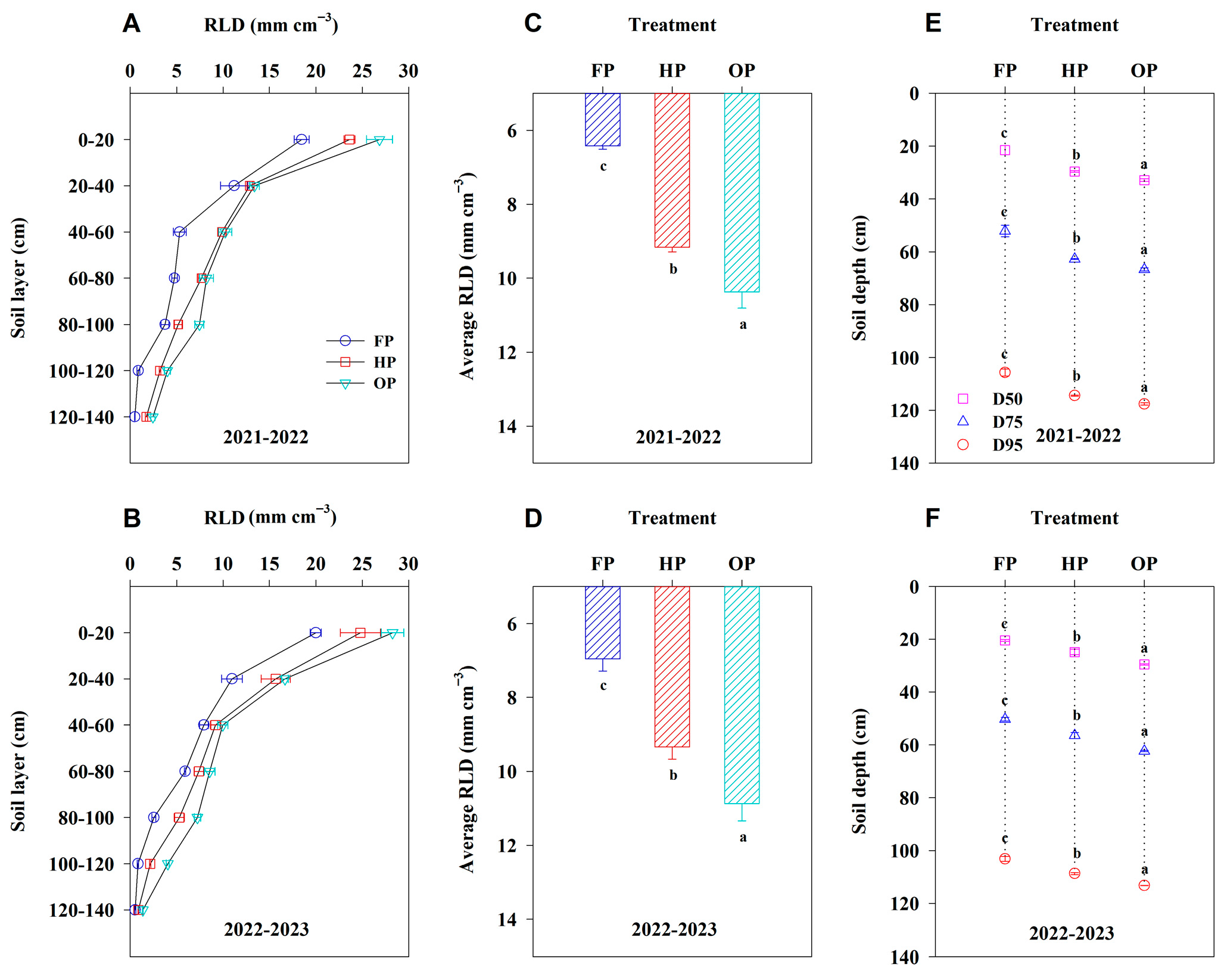
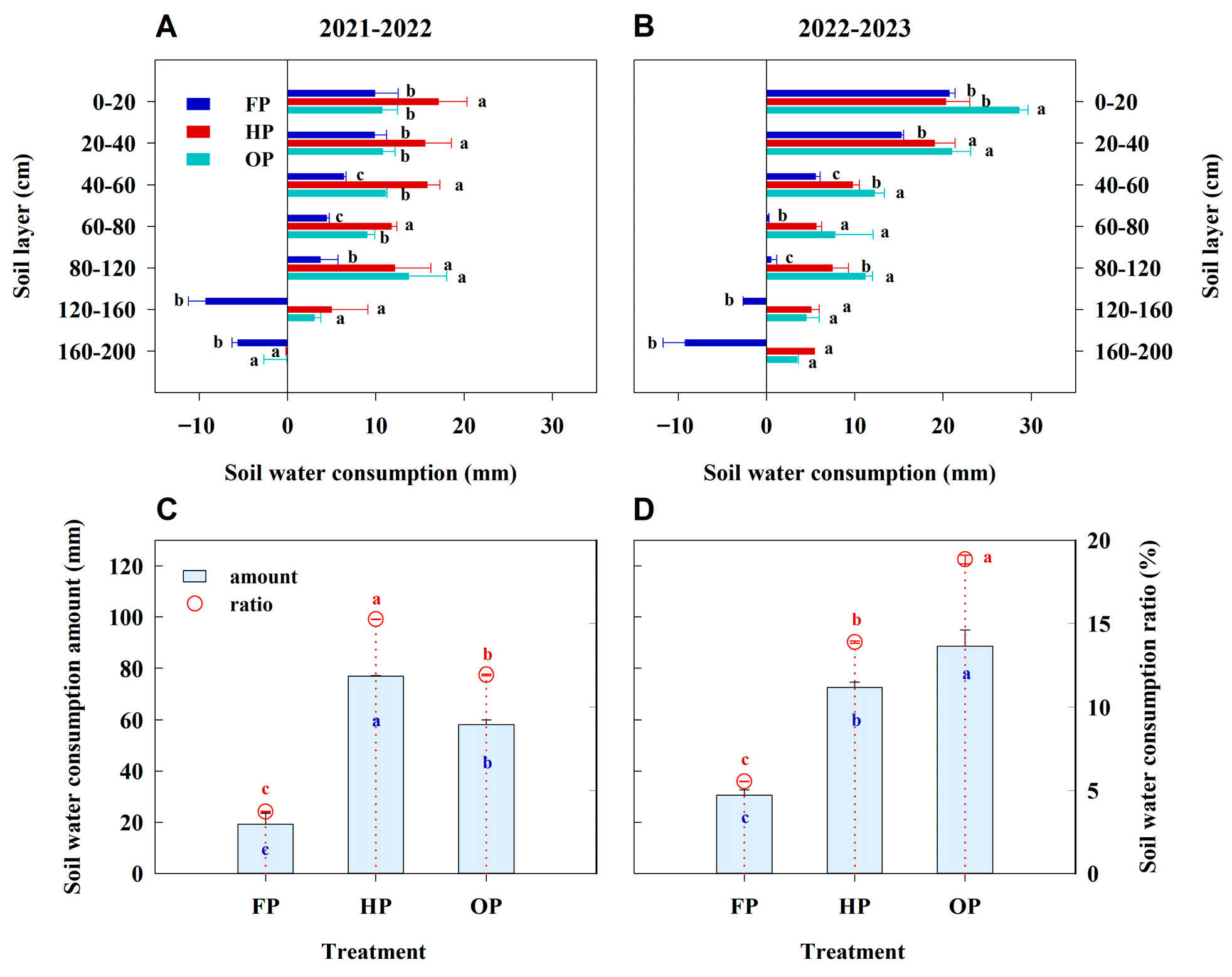
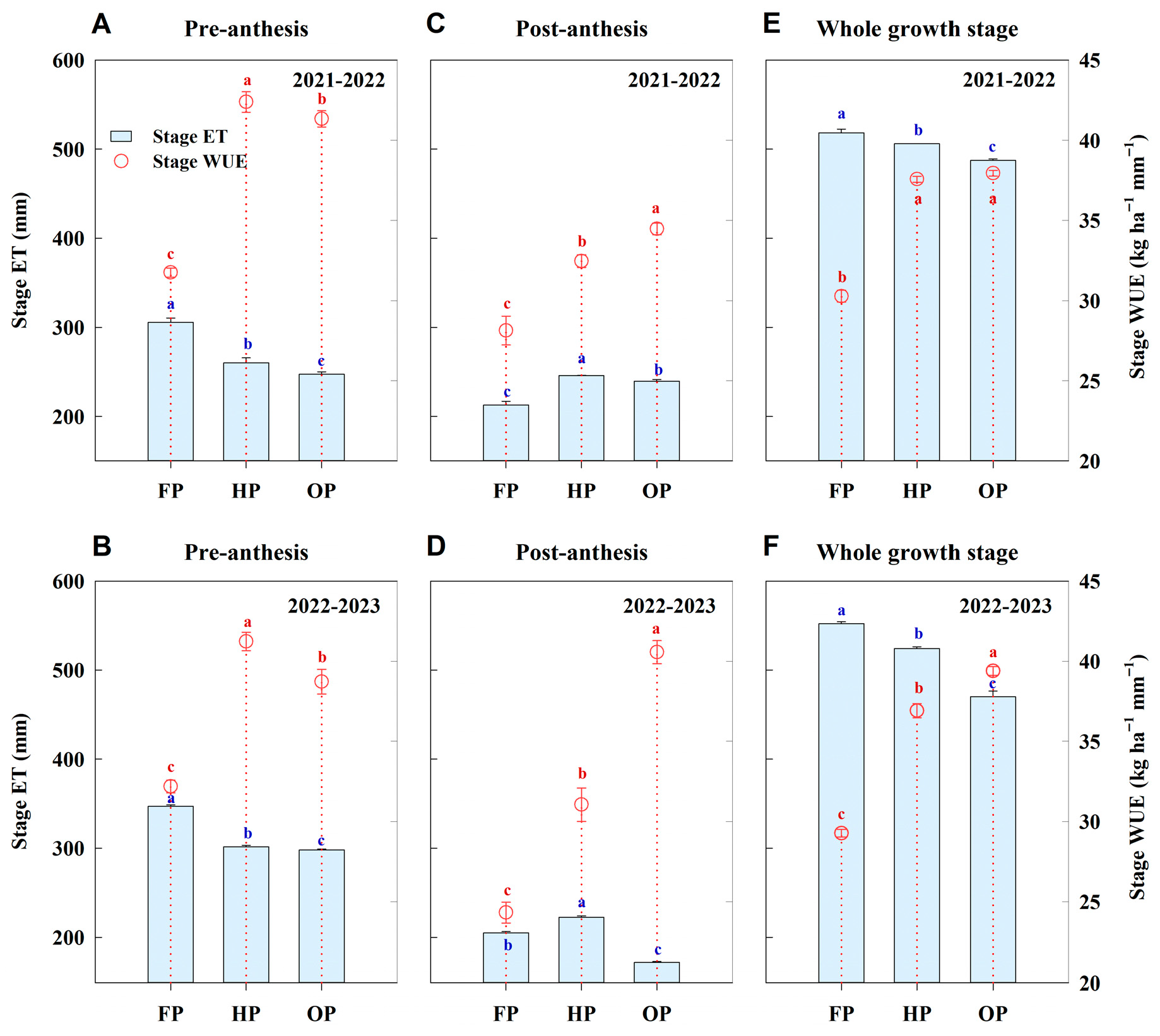
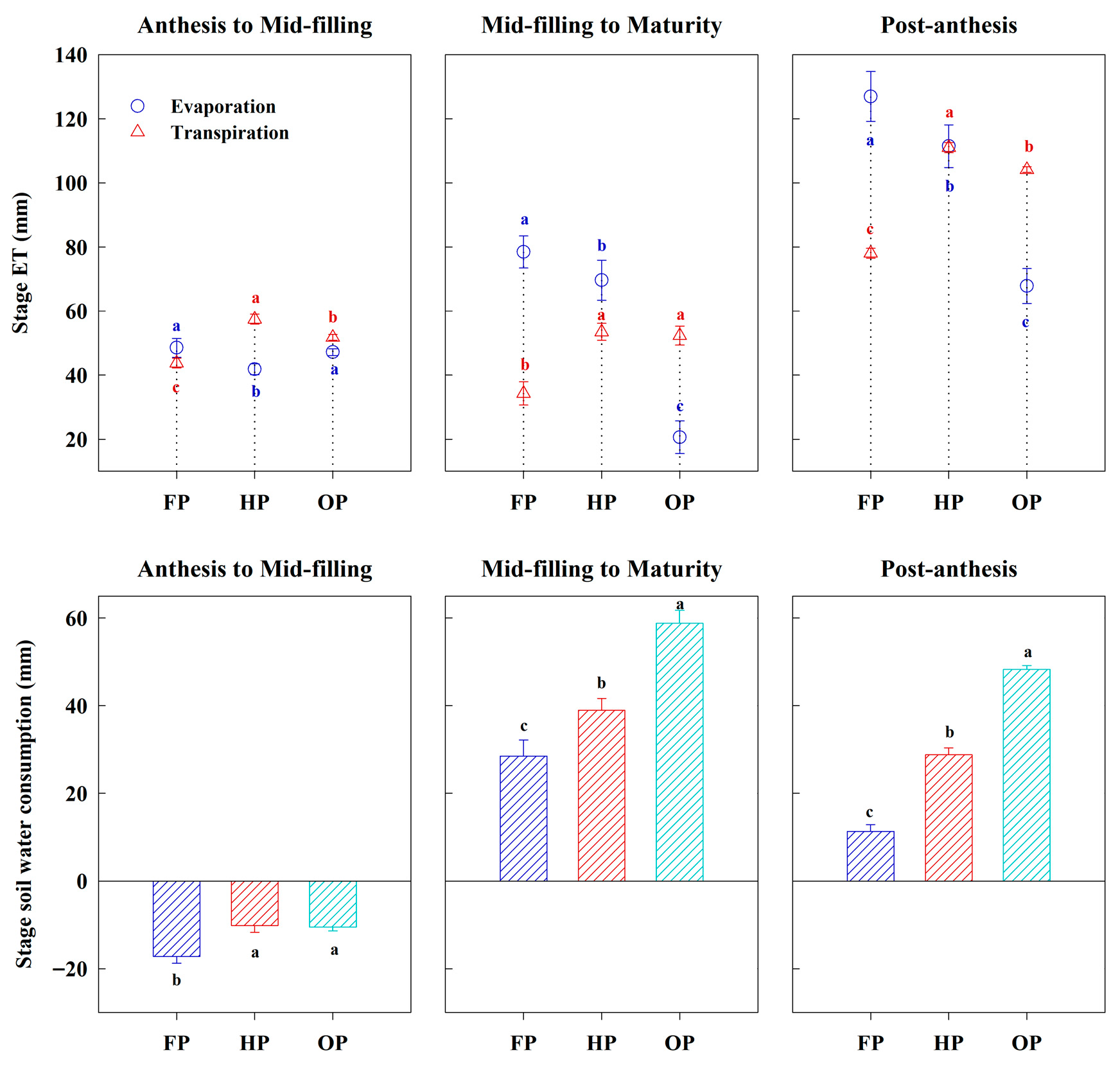

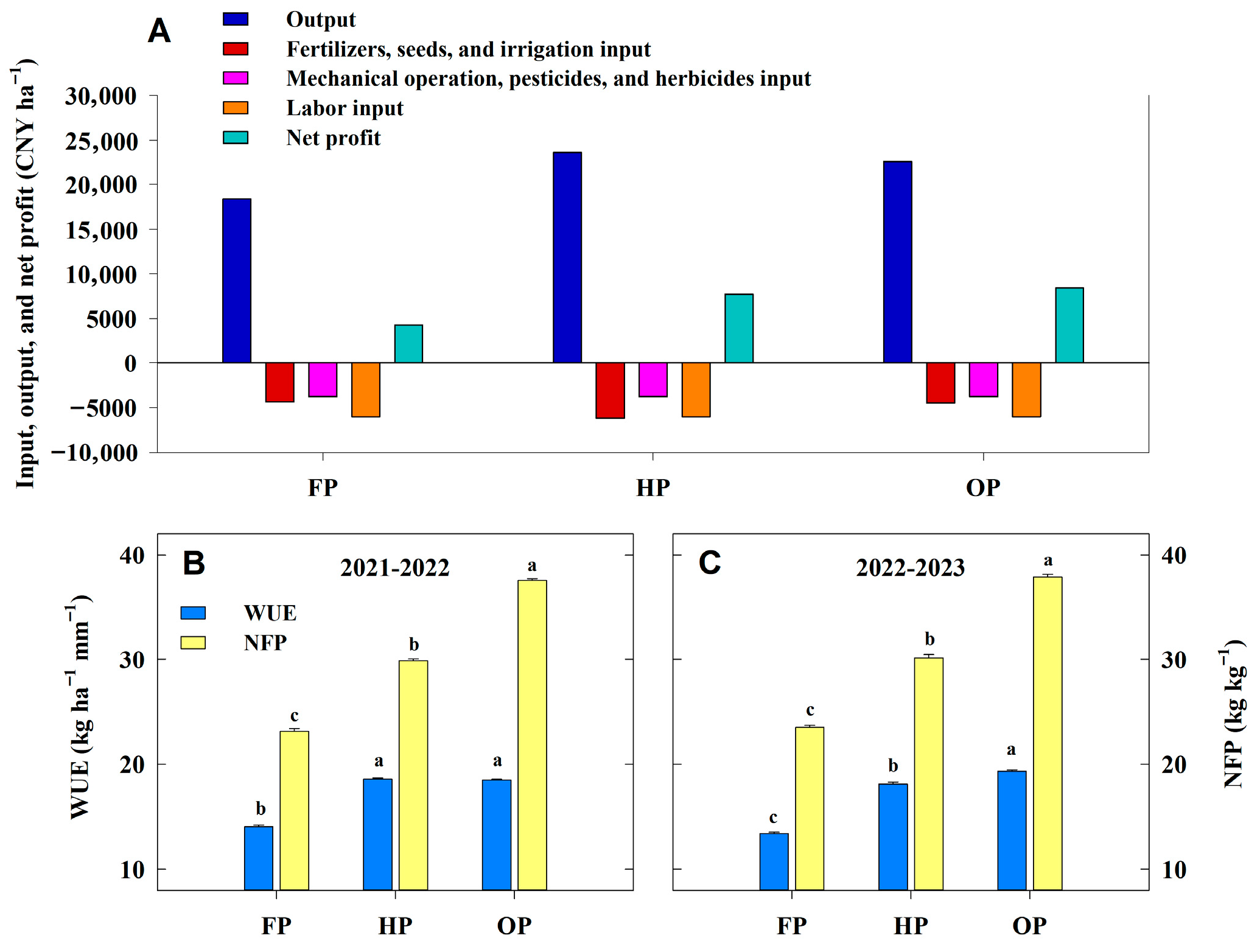

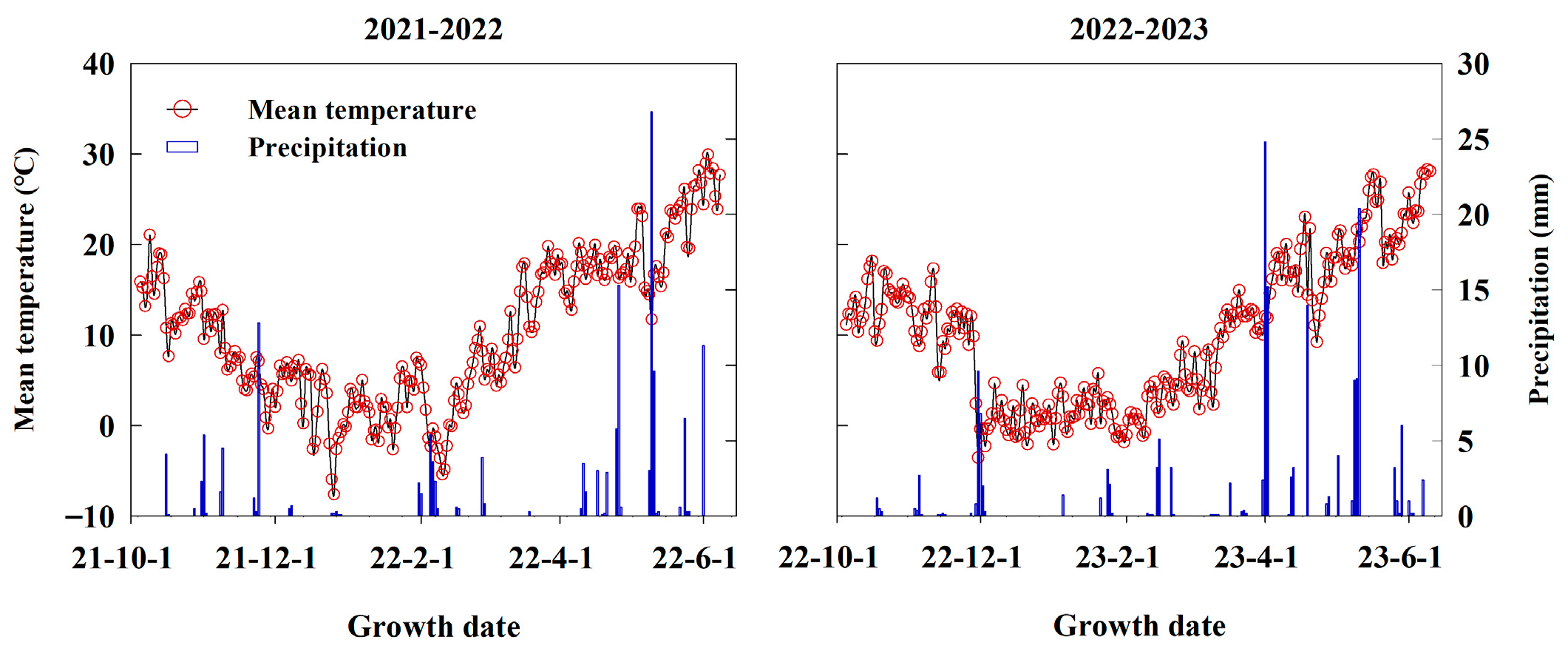
| Year | Treatment | Shoot Number Per Plant | Shoot Number Per Unit Area (103 m−2) | Root Number Per Plant | Root Number Per Unit Area (103 m−2) | ||||
|---|---|---|---|---|---|---|---|---|---|
| At Jointing | At Anthesis | At Jointing | At Anthesis | At Jointing | At Anthesis | At Jointing | At Anthesis | ||
| 2021–2022 | FP | 7.75 ± 0.11 a | 2.44 ± 0.08 a | 1.74 ± 0.02 b | 0.55 ± 0.02 c | 24.87 ± 0.24 a | 36.81 ± 1.03 a | 5.59 ± 0.05 c | 8.28 ± 0.23 c |
| HP | 5.41 ± 0.11 b | 1.69 ± 0.09 b | 2.03 ± 0.04 a | 0.63 ± 0.04 b | 16.69 ± 0.23 b | 27.83 ± 0.33 b | 6.26 ± 0.08 b | 10.43 ± 0.12 b | |
| OP | 4.37 ± 0.06 c | 1.51 ± 0.04 c | 1.97 ± 0.03 a | 0.68 ± 0.02 a | 14.91 ± 0.28 c | 26.19 ± 0.59 b | 6.71 ± 0.13 a | 11.79 ± 0.26 a | |
| 2022–2023 | FP | 8.01 ± 0.51 a | 2.61 ± 0.03 a | 1.80 ± 0.11 b | 0.59 ± 0.01 c | 33.80 ± 0.18 a | 49.31 ± 0.50 a | 7.61 ± 0.04 c | 11.09 ± 0.11 c |
| HP | 5.72 ± 0.13 b | 1.82 ± 0.03 b | 2.15 ± 0.09 a | 0.68 ± 0.01 b | 26.88 ± 0.64 b | 42.68 ± 0.54 b | 10.08 ± 0.24 b | 16.00 ± 0.21 b | |
| OP | 4.67 ± 0.01 c | 1.57 ± 0.04 c | 2.10 ± 0.01 a | 0.71 ± 0.02 a | 24.55 ± 0.11 c | 40.21 ± 0.47 c | 11.05 ± 0.05 a | 18.10 ± 0.22 a | |
| p-value | |||||||||
| Year (Y) | 0.0650 | 0.0001 | 0.0327 | 0.0002 | 0.0001 | 0.0001 | 0.0001 | 0.0001 | |
| Treatment (T) | 0.0001 | 0.0001 | 0.0009 | 0.0001 | 0.0001 | 0.0001 | 0.0001 | 0.0001 | |
| Y × T | 0.9871 | 0.1689 | 0.6708 | 0.5085 | 0.0879 | 0.0863 | 0.0001 | 0.0001 | |
| Year | Treatment | Grain Yield (kg ha−1) | Pre-Anthesis Biomass Remobilization | Post-Anthesis Biomass Production | ||
|---|---|---|---|---|---|---|
| Amount (kg ha−1) | Contribution Rate (%) | Amount (kg ha−1) | Contribution Rate (%) | |||
| 2021–2022 | FP | 7295.24 ± 88.99 c | 1311.03 ± 102.39 b | 17.99 ± 1.63 a | 5984.21 ± 191.39 c | 82.01 ± 1.63 c |
| HP | 9409.29 ± 47.83 a | 1424.21 ± 48.84 a | 15.14 ± 0.60 b | 7985.08 ± 96.66 b | 84.86 ± 0.60 b | |
| OP | 9010.58 ± 43.36 b | 748.51 ± 45.63 c | 8.31 ± 0.55 c | 8262.07 ± 88.98 a | 91.69 ± 0.55 a | |
| 2022–2023 | FP | 7418.22 ± 61.20 c | 2431.58 ± 72.08 b | 32.79 ± 1.24 a | 4986.64 ± 133.28 b | 67.21 ± 1.24 c |
| HP | 9489.69 ± 113.30 a | 2581.58 ± 117.70 a | 27.22 ± 1.55 b | 6908.11 ± 230.99 a | 72.78 ± 1.55 b | |
| OP | 9086.09 ± 60.67 b | 2110.97 ± 62.99 c | 23.24 ± 0.85 c | 6975.12 ± 123.65 a | 76.76 ± 0.85 a | |
| p-value | ||||||
| Year (Y) | 0.0062 | 0.0001 | 0.0001 | 0.0001 | 0.0001 | |
| Treatment (T) | 0.0001 | 0.0001 | 0.0001 | 0.0001 | 0.0001 | |
| Y × T | 0.7778 | 0.0148 | 0.0392 | 0.1765 | 0.0392 | |
| Year | Treatment | N accumulation in Grains (kg ha−1) | Pre-Anthesis N Remobilization | Post-Anthesis N Uptake | ||
|---|---|---|---|---|---|---|
| Amount (kg ha−1) | Contribution Rate (%) | Amount (kg ha−1) | Contribution Rate (%) | |||
| 2021–2022 | FP | 159.45 ± 2.27 c | 144.34 ± 3.19 c | 90.53 ± 1.78 a | 15.11 ± 2.88 c | 9.47 ± 1.78 c |
| HP | 223.10 ± 3.05 a | 191.21 ± 2.66 a | 85.72 ± 1.97 b | 31.89 ± 4.76 b | 14.28 ± 1.97 b | |
| OP | 206.55 ± 3.21 b | 167.49 ± 2.37 b | 81.11 ± 1.94 c | 39.06 ± 4.51 a | 18.89 ± 1.94 a | |
| 2022–2023 | FP | 173.22 ± 0.03 c | 162.43 ± 3.68 c | 93.77 ± 2.11 a | 10.78 ± 3.65 b | 6.23 ± 2.11 c |
| HP | 240.47 ± 1.76 a | 210.93 ± 4.14 a | 87.71 ± 1.16 b | 29.54 ± 2.63 a | 12.29 ± 1.16 b | |
| OP | 216.95 ± 1.47 b | 184.52 ± 3.58 b | 85.05 ± 1.31 c | 32.42 ± 2.76 a | 14.95 ± 1.31 a | |
| p-value | ||||||
| Year (Y) | 0.0001 | 0.0001 | 0.0004 | 0.0078 | 0.0004 | |
| Treatment (T) | 0.0001 | 0.0001 | 0.0001 | 0.0001 | 0.0001 | |
| Y × T | 0.0205 | 0.7229 | 0.5382 | 0.5112 | 0.5384 | |
| Treatment | Sowing Date (m/d) | Planting Density (Seeds m−2) | Fertilization | Irrigation | ||||
|---|---|---|---|---|---|---|---|---|
| Fertilizer | Pre-Sowing Amount (kg ha−1) | Topdressing Amount (kg ha−1) | Topdressing Timing | Frequency and Timing | Amount (mm) | |||
| FP | 10/5 | 225 | N | 189 | 126 | Regreening | 5 times (Post-sowing, Before winter, Regreening, Anthesis, and Mid-filling) | 350 |
| P2O5 | 120 | − | − | |||||
| K2O | 30 | − | − | |||||
| HP | 10/10 | 375 | N | 126 | 189 | Jointing | 4 times (Post-sowing, Jointing, Anthesis, and Mid-filling) | 280 |
| P2O5 | 210 | − | − | |||||
| K2O | 150 | − | − | |||||
| OP | 10/15 | 450 | N | 96 | 144 | Jointing | 4 or 3 times (Post-sowing, Jointing, Anthesis, or Mid-filling) | 280 or |
| P2O5 | 120 | − | − | 210 | ||||
| K2O | 75 | − | − | |||||
Disclaimer/Publisher’s Note: The statements, opinions and data contained in all publications are solely those of the individual author(s) and contributor(s) and not of MDPI and/or the editor(s). MDPI and/or the editor(s) disclaim responsibility for any injury to people or property resulting from any ideas, methods, instructions or products referred to in the content. |
© 2025 by the authors. Licensee MDPI, Basel, Switzerland. This article is an open access article distributed under the terms and conditions of the Creative Commons Attribution (CC BY) license (https://creativecommons.org/licenses/by/4.0/).
Share and Cite
Xu, H.; Zhao, F.; Tang, Y.; Xue, Q.; Zhang, J.; Peng, D.; Dai, X. Optimized High-Input Practice Enhances Wheat Productivity and Water Use Efficiency by Improving Root Distribution and Canopy Photosynthesis. Plants 2025, 14, 3176. https://doi.org/10.3390/plants14203176
Xu H, Zhao F, Tang Y, Xue Q, Zhang J, Peng D, Dai X. Optimized High-Input Practice Enhances Wheat Productivity and Water Use Efficiency by Improving Root Distribution and Canopy Photosynthesis. Plants. 2025; 14(20):3176. https://doi.org/10.3390/plants14203176
Chicago/Turabian StyleXu, Haicheng, Fei Zhao, Yuhai Tang, Qiqin Xue, Jingmin Zhang, Dianliang Peng, and Xinglong Dai. 2025. "Optimized High-Input Practice Enhances Wheat Productivity and Water Use Efficiency by Improving Root Distribution and Canopy Photosynthesis" Plants 14, no. 20: 3176. https://doi.org/10.3390/plants14203176
APA StyleXu, H., Zhao, F., Tang, Y., Xue, Q., Zhang, J., Peng, D., & Dai, X. (2025). Optimized High-Input Practice Enhances Wheat Productivity and Water Use Efficiency by Improving Root Distribution and Canopy Photosynthesis. Plants, 14(20), 3176. https://doi.org/10.3390/plants14203176





